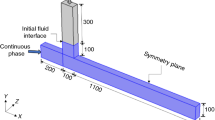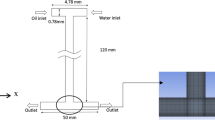Abstract
The internal flow field during droplet formation stage accompanied with mass transfer is heuristically investigated in a T-junction micro-channel. De-ionized water/phosphate acid/butanol is used as the working system. Micro-PIV measurement is conducted to capture the velocity distribution inside the droplet. Experimental results illustrate that as the mass transfer is involved in this process, the dispersion size of droplet is decreased. There exists an internal circulation inside the droplet during formation stage in the T-shape micro-channel. The velocity of vortex inside the droplet can be reduced when the mass transfer process is enhanced. A parameter of swirling strength is applied to demonstrate the convection effect inside the droplet. At the initial stage of the formation process, swirling strength of the vortices is increased as the phosphate acid concentration increases. But, as the generation of droplet, the swirling strength of the condition with lower phosphate acid concentration increases much faster than that with higher phosphate acid concentration. The experiment results can help to explore the mass transfer mechanism in micro-devices.








Similar content being viewed by others
Abbreviations
- d e :
-
Effective diameter of seeding particles on CCD (µm)
- d p :
-
Diameter of seeding particles (µm)
- d s :
-
Point spread function (µm)
- M :
-
Magnification of the lens
- NA:
-
Numerical aperture (dimensionless)
- FOV:
-
The resolution of the CCD (m)
- n :
-
The number of pixels per interrogation region (pixel)
- RES:
-
The field of view in the flow direction (pixel)
- Δt :
-
Time interval (s)
- T :
-
Generation time of the droplet in a whole period (s)
- U max :
-
Maximum velocity in the flow direction (m/s)
- λ :
-
Swirling strength (dimensionless)
- ɛ :
-
Generation extent of a droplet (dimensionless)
References
Adrian RJ, Christensen KT, Liu Z-C (2000) Analysis and interpretation of instantaneous turbulent velocity fields. Exp Fluids 29:275–290
Burkhart L, Weathers PW, Sharer PC (1976) Mass transfer and internal circulation in forming drops. AIChE J 22(6):1090–1096
Dittrich PS, Manz A (2006) Lab-on-a-chip: microfluidics in drug discovery. Nat Rev Drug Discov 5:201–218
Duxenneuner MR, Fischer P, Windhab EJ, Cooper-White JJ (2014) Simultaneous visualization of the flow inside and around droplets generated in micro-channels. Microfluidics Nanofluidics 16:743–755
Garstecki P, Fuerstman MJ, Stone HA, Whitesides GM (2006) Formation of droplets and bubbles in a microfluidic T-junction—scaling and mechanism of break-up. Lab Chip 6:437–446
Glawdel T, Elbuken C, Ren CL (2012a) Droplet formation in microfluidic T-junction generators operating in the transitional regime. I. Experimental observation. Phys Rev E 85:016322
Glawdel T, Elbuken C, Ren CL (2012b) Droplet formation in microfluidic T-junction generators operating in the transitional regime. II. Modeling. Phys Rev E 85:016323
Hardt S, Hahn T (2012) Microfluidics with aqueous two-phase systems. Lab Chip 12:434–442
Horton TJ, Fritsch TR, Kintner RC (1965) Experimental determination of circulation velocities inside drops. Can J Chem Eng 43(3):143–146
Janasek D, Franzke J, Manz A (2006) Scaling and the design of miniaturized chemical-analysis systems. Nature 442(27):374–380
King C, Walsh E, Grimes R (2007) PIV measurements of flow within plugs in a microchannel. Microfluidics Nanofluidics 3:463–472
Kinoshita H, Kaneda S, Fujii T, Oshima M (2007) Three-dimensional measurement and visualization of internal flow of a moving droplet using confocal micro-PIV. Lab Chip 7:338–346
Lan WJ, Li SW, Wang YJ, Luo GS (2014) CFD simulation of droplet formation in microchannels by a modified level set method. Ind Eng Chem Res 53:4913–4921
Lee JN, Park C, Whitesides GM (2003) Solvent compatibility of poly(dimethylsiloxane)-based microfluidic devices. Anal Chem 75:6544–6554
Lindken R, Rossi M, Große S, Westerweel J (2009) Micro-particle image velocimetry (µPIV): recent developments, applications, and guidelines. Lab Chip 9:2551–2567
Lu YT, Fu TT, Zhu CY, Ma YG, Li HZ (2014) Scaling of the bubble formation in a flow-focusing device: role of the liquid viscosity. Chem Eng Sci 105:213–219
Meinhart CD, Wereley ST, Santiago JG (1999) PIV measurements of a microchannel flow. Exp Fluids 27:414–419
Sarrazin F, Loubière K, Prat L, Gourdon C, Bonometti T, Magnaudet J (2006) Experimental and numerical study of droplets hydrodynamics in microchannels. AIChE J 52(12):4061–4070
Shao HW, Lu YC, Wang K, Luo GS (2012) An experimental study of liquid–liquid microflow pattern maps accompanied with mass transfer. Chin J Chem Eng 20(1):18–26
Walsh PA, Egan VM, Walsh EJ (2010) Novel micro-PIV study enables a greater understanding of nanoparticle suspension flows: nanofluids. Microfluidics Nanofluidcs 8:837–842
Wang K, Lu YC, Xu JH, Tan J, Luo GS (2011) Generation of micromonodispersed droplets and bubbles in the capillary embedded T-junction microfluidic devices. AIChE J 57(2):299–306
Wang X, Yong YM, Fan P, Yu GZ, Yang C, Mao Z-S (2012) Flow regime transition for concurrent gas–liquid flow in micro-channels. Chem Eng Sci 69(1):578–586
Wang K, Xie LS, Lu YC, Luo GS (2013) Generating microbubbles in a co-flowing microfluidic device. Chem Eng Sci 100:486–495
Wang X, Yong YM, Yu GZ, Yang C, Mao Z-S (2014a) Investigation on pressure drop characteristic and mass transfer performance of gas–liquid flow in micro-channels. Microfluidics Nanofluidics 16(1–2):413–423
Wang XY, Wang K, Riaud A, Wang X, Luo GS (2014b) Experimental study of liquid/liquid second-dispersion process in constrictive microchannels. Chem Eng J 254:443–451
Whitesides GM (2006) The origins and the future of microfluidics. Nature 442(27):368–373
Xu JH, Li SW, Tan J, Luo GS (2008a) Correlations of droplet formation in T-junction microfluidic devices: from squeezing to dripping. Microfluidics Nanofluidics 5:711–717
Xu JH, Tan J, Li SW, Luo GS (2008b) Enhancement of mass transfer performance of liquid–liquid system by droplet flow in microchannels. Chem Eng J 141:242–249
Zhang JS, Wang K, Lin XY, Lu YC, Luo GS (2014) Intensification of fast exothermic reaction by gas agitation in a microchemical system. AIChE J 60(7):2724–2730
Acknowledgment
Financial supports from National Natural Science Foundation of China (21406129, 91334201, U1463208, U1302271) and China Postdoctoral Science Foundation (2014M550741) are gratefully acknowledged.
Author information
Authors and Affiliations
Corresponding author
Additional information
Xi Wang and Guotao Liu have contributed equally to this work.
Rights and permissions
About this article
Cite this article
Wang, X., Liu, G., Wang, K. et al. Measurement of internal flow field during droplet formation process accompanied with mass transfer. Microfluid Nanofluid 19, 757–766 (2015). https://doi.org/10.1007/s10404-015-1600-6
Received:
Accepted:
Published:
Issue Date:
DOI: https://doi.org/10.1007/s10404-015-1600-6




